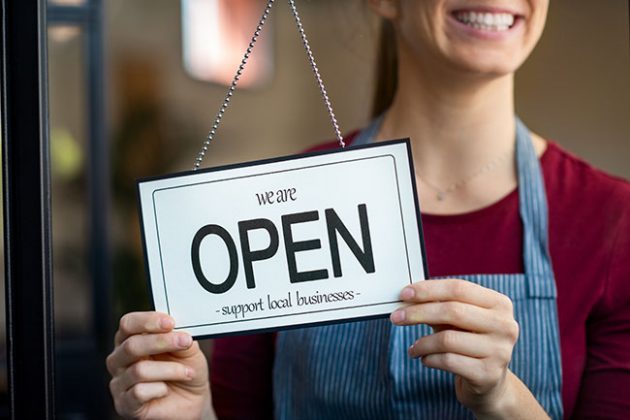
Considerations for reopening your dining room
By Canadian Pizza
COVID-19 Updates Features Business and Operations Health & Safety Premises Canadian Centre for Occupational Health and Safety CCOHS Open for business sign. Photo courtesy of Fotolia
Open for business sign. Photo courtesy of Fotolia Canadian restaurants are slowly and cautiously planning to reopen their dining rooms. To help operators map out their next steps, Canadian Pizza spoke with Amy Campbell, BHSc, DOHS, CRSP, who is health and safety program manager for the Canadian Centre for Occupational Health and Safety.
In addition to consulting your provincial/territorial government guidelines and public health departments, Campbell recommended taking a phased approach to integrated safety measures. A key thing to consider is risk of exposure. What functions or activities in your restaurant are high-risk?
What functions or activities in your restaurant are high-risk?
Many businesses are currently doing curbside takeout or delivery, and these involved, generally speaking, a lower risk than dining in. Once patrons are invited to dine in, operators need to amplify efforts, she said. That includes handwashing, cleaning and sanitization, and physical distancing.
Engage regularly with your workers and health and your safety committee, she recommeded. “They have good perspective and insight and are already engaged in organizing controls that will protect everyone. Their input is valuable.”
With information coming in rapidly, regular and frequent communication is necessary to protect yourselves and your customers, she said. There are different ways to reduce the transmission and by engaging your employees, you can better understand where in your operation there are higher risks.
For businesses with dining rooms, extra time will be required to clean and sanitize. Operators should determine how much time those activities will take, and make sure there are proper time, materials and personnel to do that work.
Before inviting the public in again, assess what the capacity of your space is to maintain the two-metre distances at the entrance/exit and in seating areas. How can your operation maintain the required distance? Demarcations on the floor and on tabletops (such as taping an “X”) are a good option. Tables may be removed, stacked or possibly used to create pathways to show people where they should be going.
Key considerations include reduced facility capacity, additional cleaning and sanitization, and communicating to customers how new measures will impact service and wait times
Plexiglas barriers can increase the physical barriers between staff and customers and among groups of customers. Tablecloths are not recommended if only for practical reasons. “If you’re handling laundry, you would want employees to wear mask and gloves when doing so,” Campbell said, adding that hard surfaces are a good choice because they are easily sanitized. Removing condiments and shared items also will help keep minimize transmission of the virus.
Create menus on wall spaces instead of handing out paper menus, she suggested.
Supplier-restaurant measures
As for supplier-restaurant relations, Campbell recommends offering hand sanitizers to representatives making deliveries to the restaurant and taking time to clean or wipe down places where items are placed.
Encouraging contactless payment among both suppliers and customers is to everyone’s benefit, she said.
When people have to work in close proximity, masks and gloves will help reduce risk of transmission, she said. Enquire of your suppliers what measures they have, contactless payment, receiving orders outdoors, how can you safely offload without sharing things like dollies.
What should be top of mind for operators?
What factors should be top of mind before an operator opens their dining room again? When operators prepare to open, they will want to assess the number of patrons and workers that can be safely accommodated inside while maintaining the required physical distance.
“Work with health and safety committee members or representatives to determine how people will use your facilities,” Campbell said. “Run through typical scenarios. That will lead you through what you need to do and help you assess how can you properly clean your establishment.”
“Risk communication is critically important,” she said. The way in which an operator engages with their employees and informs them of the risk and what precautions they’re taking to control that, are essential to managing this transition time. When workers feel confident that the precautions reflect the best available advice from public health agencies and that there is frequent and reliable communication about health and safety – that goes a long way. That regular two-way communication between employers and the workforce is really valuable.”
Looking further ahead
Which precautions will be enduring over time? The two key measures Campbell has consistently heard are physical distancing and handwashing. Those will continue as necessary, enduring precautionary measures, she said, for individuals in their homes as well. She expects to see increased attention to cleaning and sanitization and what that requires in time, resources and education. How people can protect themselves from hazardous materials and how to handle waste from cleaning activities are other areas that will continue to concern us.
Campbell said it’s important to communicate with your customers in this new normal: “It will look different, it will feel different and their experience will be different, so managing expectations will be top of mind for business owners as well.”
CCOHS resources
- Infectious Disease Outbreak portal
- Pandemic COVID-19 Tip Sheets
- Restaurants and Food Services Tip Sheet
Other helpful resources
Print this page